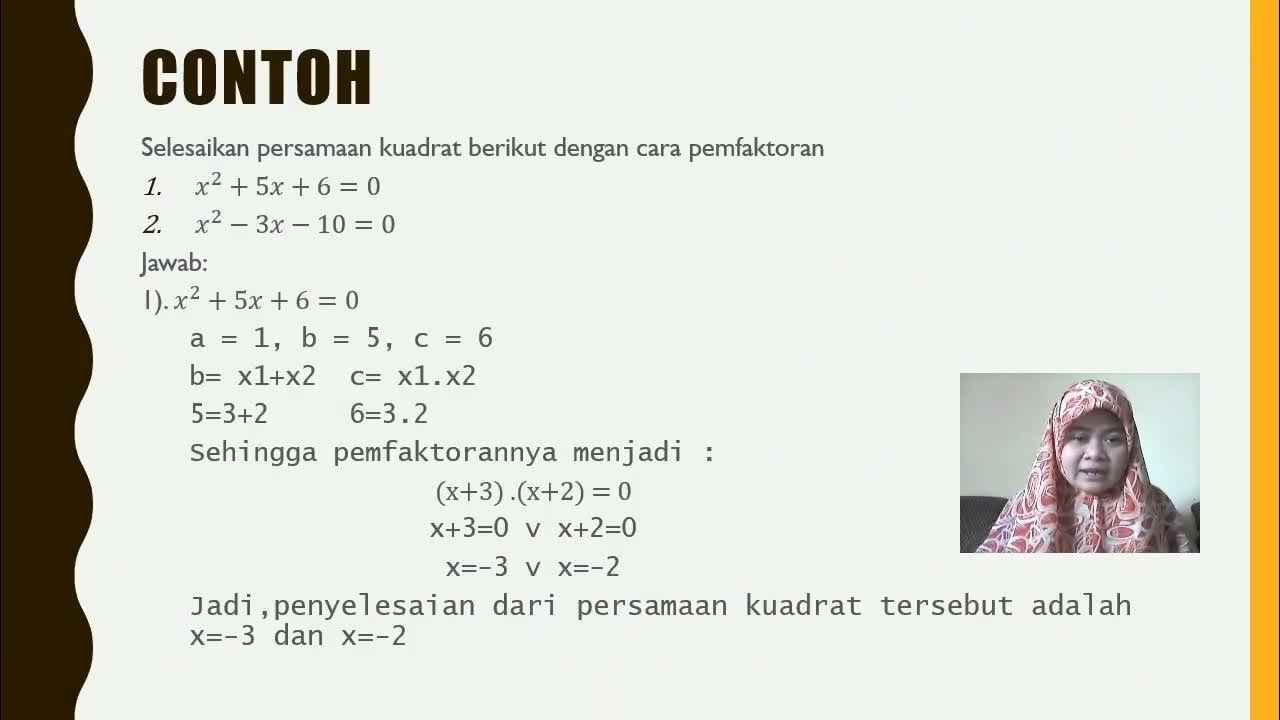karakteristik fungsi kuadrat berdasarkan nilai a, b dan c
Summary
TLDRIn this video, the speaker explains the characteristics of quadratic functions based on the values of a, b, and c in the general form of f(x) = ax² + bx + c. The discussion highlights how changes in these values affect the graph, including the shape, direction, and position of the parabola. The impact of the 'a' value on the curvature, the 'b' value on horizontal shifts, and the 'c' value on vertical shifts is demonstrated through various examples, offering a clear understanding of how each parameter alters the graph's appearance.
Takeaways
- 😀 The general form of a quadratic function is f(x) = ax² + bx + c.
- 😀 The value of 'a' affects the direction of the parabola: if 'a' is positive, it opens upwards, and if 'a' is negative, it opens downwards.
- 😀 If 'a' is equal to zero, the function becomes linear (a straight line).
- 😀 The magnitude of 'a' controls the width of the parabola: a larger magnitude makes the parabola narrower, and a smaller magnitude makes it wider.
- 😀 The value of 'b' shifts the graph horizontally. Positive values of 'b' move the graph to the right, while negative values move it to the left.
- 😀 The value of 'c' determines the vertical shift of the graph: positive values move the graph up, while negative values move it down.
- 😀 A change in the value of 'a' affects the curvature of the graph, with smaller values making the parabola wider and larger values making it narrower.
- 😀 The vertex of the parabola can be affected by changes in 'b', which shifts the graph horizontally.
- 😀 When 'b' is zero, the graph is symmetric about the y-axis.
- 😀 The graph of a quadratic function is a curve (parabola), but if 'a' equals zero, the graph becomes a straight line.
- 😀 The graph of a quadratic function can be shifted both horizontally (by changing 'b') and vertically (by changing 'c'), allowing for flexibility in positioning the graph.
Q & A
What is the general form of a quadratic function?
-The general form of a quadratic function is f(x) = ax² + bx + c.
What happens to the graph of a quadratic function when the value of 'a' is 0?
-When 'a' equals 0, the graph of the quadratic function changes from a parabola to a straight line, no longer representing a quadratic function.
How does the value of 'a' affect the direction the parabola opens?
-When 'a' is positive, the parabola opens upwards. When 'a' is negative, the parabola opens downwards.
What happens to the width of the parabola as the value of 'a' increases or decreases?
-As the absolute value of 'a' increases (whether positive or negative), the parabola becomes narrower. As the absolute value of 'a' decreases, the parabola becomes wider.
How does the value of 'b' affect the graph of the quadratic function?
-The value of 'b' shifts the graph horizontally. A positive value of 'b' shifts the graph to the right, while a negative value of 'b' shifts the graph to the left.
What is the effect of changing 'c' on the graph of the quadratic function?
-The value of 'c' affects the vertical position of the graph. When 'c' is positive, the graph shifts upwards, and when 'c' is negative, the graph shifts downwards.
What happens to the shape of the graph if 'a' is very large (either positive or negative)?
-If 'a' is very large (in absolute value), the graph becomes much narrower. This is true whether 'a' is positive or negative.
Can a quadratic function still be a parabola if 'a' is zero?
-No, if 'a' is zero, the function no longer represents a quadratic function but instead becomes a linear function, i.e., a straight line.
How can you determine if a parabola opens upward or downward based on the value of 'a'?
-If the value of 'a' is positive, the parabola opens upwards. If the value of 'a' is negative, the parabola opens downwards.
How does the combination of 'a', 'b', and 'c' determine the final shape and position of the graph?
-The value of 'a' determines the direction the parabola opens and its width. The value of 'b' shifts the graph horizontally, and the value of 'c' shifts the graph vertically. Together, these values control the overall shape and position of the graph.
Outlines

This section is available to paid users only. Please upgrade to access this part.
Upgrade NowMindmap

This section is available to paid users only. Please upgrade to access this part.
Upgrade NowKeywords

This section is available to paid users only. Please upgrade to access this part.
Upgrade NowHighlights

This section is available to paid users only. Please upgrade to access this part.
Upgrade NowTranscripts

This section is available to paid users only. Please upgrade to access this part.
Upgrade NowBrowse More Related Video

Matematika Kelas 9 : Fungsi Kuadrat (Part 1 : Bentuk umum dan grafik fungsi kuadrat)

Writing a Quadratic Function from Points (Example)

Intro to Quadratic Functions (Relations) - Nerdstudy

Persamaan Kuadrat part 1

TRANSFORMING QUADRATIC FUNCTIONS FROM GENERAL FORM TO STANDARD/VERTEX FORM AND VICE VERSA

Comparing Linear, Exponential, and Quadratic Functions
5.0 / 5 (0 votes)